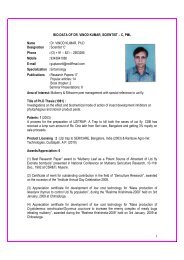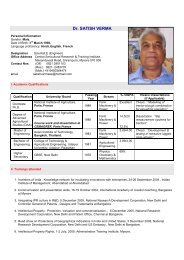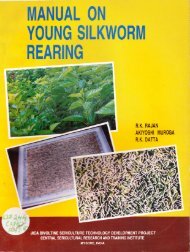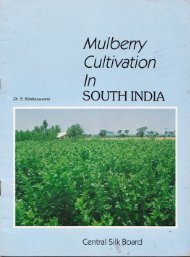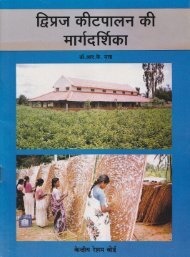BIVOLTINE RACE AND
Manual on Bivoltine Rearing, Race Maintenance and Multiplication
Manual on Bivoltine Rearing, Race Maintenance and Multiplication
- No tags were found...
You also want an ePaper? Increase the reach of your titles
YUMPU automatically turns print PDFs into web optimized ePapers that Google loves.
During incubation, hurnidity is rnaintained at 75-8&%a. Excessive dryness resuigs in dead<br />
eggs, poor hatching and weak Larvae. tsut very high humidity (90-iOE %) btings unfavourable<br />
effect on the eggs (grown larvae tlecomes weak)"<br />
Temperature during incutiation has a great influence on the voltinism of silkwornns. If the<br />
ternperature is maintained at 15"C during ineubation, the bivoltine breeds/races would tend<br />
to deveiop non-hi$ernating characteristics, {f 23 - 25"C temperature is maintained, they tend<br />
to trecorne hibernating ones. Rearing of hihcrnating eggs. usually gives better erop than that<br />
of non-diapause eggs. Therefore, bivoltine eggs should be incubated at 25"C. {n places having<br />
higher temperature, an airc*nditi*$er can be used for lowering the ternperature while in cooler<br />
piaees ireater with thea"rnostatie eontrol meciranisrn helps to keep a constant temperature<br />
ospecialtry in the night during incubation wtrich is veey imrportant. Ar far as possibtre ineutrated<br />
layings can tre supplied to the farmers.<br />
3.6. Air<br />
trneubation roofll or ehasrber must be cpcned/ventilated daily for i0 rninutes in ti:e mornlng<br />
ancl evening during inenbati*n<br />
3.7. Light<br />
The light also affects uni{orm hat*hing and voitinisrn during ineubaticn pericd" Frowr the<br />
very begrnning of ine*batio* t!f"* tlie eye spct stage, light hastens the embrycnic ql*vc- lcprnent.<br />
I{owever, during final hatching :i2ge, darkness inliibits eievei*prnc*i. Light nlore ttian 16 h*urs<br />
a day- induees the hiLrernatii,;. ,.:i:;-iecrer in silkwCIrms" The uniformity in iiatctrrng is *trtained<br />
with regulaied e*ntroi *f iiglit" .,-ight sli*utrEi h:e provirl*d for 16 hours a da3r, till heacl<br />
pigrnentati*n stage. At blue *gg staee, the eggs sh*uid b*",.<br />
g**t in darkness b3' col'ering wittl<br />
black paper eir eio{h {c *htain unif*rnr hatehing"<br />
3.8. Expasmre of, silkworm eggs to light<br />
When stray hatching is ncticed cn the egg eard {a few iarvae hatch out), t}re eggs are<br />
expcsed to iight. This ensures uniforcr hatehing and r',,ithin two hours all the larvae will hateh.<br />
The hatehing *lare can be dctermin*d by the erntlry* develelpinent with reference to the cotr*ur<br />
of the egg ancl distinctness of the egg dimple" Xn case *f X*ose eggs,th* eggs ar* spread ir: th*<br />
box qlr incuhatien trox or brushing frarne (speciaily meant feir it} in a thin lay*r by siraking<br />
ge.ntly. Cutting the egg box eover cloth through the sides without damaging tli* eggs and k**ping<br />
the sarne turned up rvith the egg stieking to it at the {in:e of expcsure to }ig}rt cari he rione {if<br />
trrushing frarne is glcrt used).<br />
3.9. Coid storage of "blue eggs" amd "rnew $'orm E&e"vmc*<br />
F{atching of eggs eluri*g ineubatioci ean be rtrelay**l by eeliC steiriieg the eggs at't:riue egg<br />
stage at 5'C feir seven days, ilut a sh*rter tim* {-i - 5 eiays} ls pr*ferabie ivhercas, nervly tratehed<br />
larvae can be ecld stored for 3 elays at 7-1*"C" T'Xle lariuridity in the e*ld stsrage roo{tt shculd<br />
not be less tlian 75 to 8*%. Wnapping t?ie egg or iarvae. container with wet cotton eloth or<br />
blotting paper helps in i*ereasing the hunddi$"


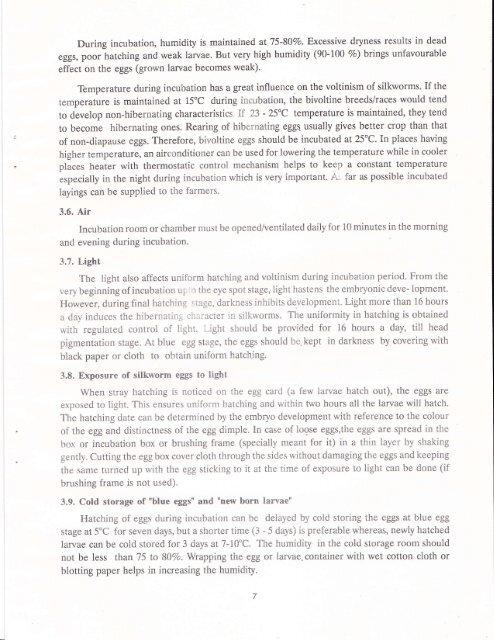

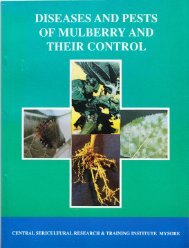

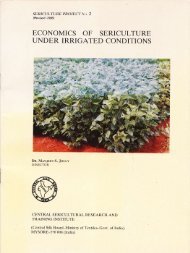
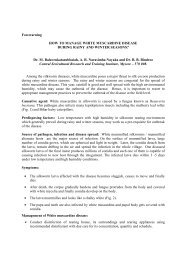
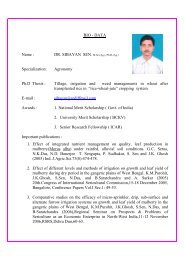
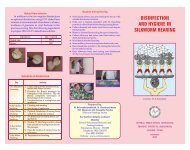
![E}A]\GALORE](https://img.yumpu.com/54052619/1/190x260/eagalore.jpg?quality=85)

